Our visit to Kumkang Mountain on the third
day was the most boring day of the trip. Even though the scenery at Kumkang was
beautiful, no matter where we looked there was nothing but nature, which is an
easy enough thing to see in China. I searched hard for any differences between
the two, and I guess Kumkang Mountain has a relatively smaller number of
people.
Kumkang Mountain is divided into three
parts: Outer Kumkang, Inner Kumkang, and Hae Kumkang. I had heard that North
Korea also uses the metaphor of ‘outside’ for men and ‘inside’ for women, and Kumkang
Mountain was like this. Outer Kumkang has a strong, masculine feeling, with
majestic, awe-inspiring landscapes. In contrast, inner Kumkang gives a softer,
more feminine impression. Hae Kumkang was historically part of the coast, but
following some shifts in the Earth’s tectonic plates, it broke off from the sea
to form a separate lake.
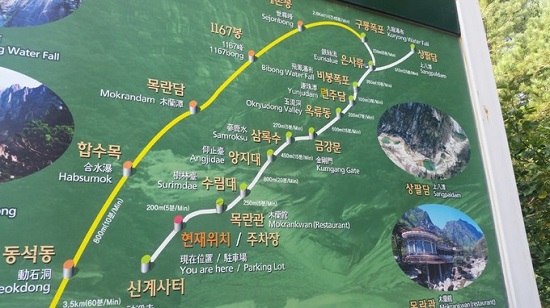
This is a map of Kumkang Mountain. The red
dot marks the place where we started our tour. From there to Kuryong Falls it
is a distance of 8km, or about a four-hour hike. Before you get to Kuryong
Falls, if you go up the small path off to the right at Unsaryu, you will see
Sang Paldam. The scenery at Kuryong Falls cannot compare to San Paldam. Even
though the trail up to Sang Paldam is incredibly difficult, it’s more than
worth the hike.
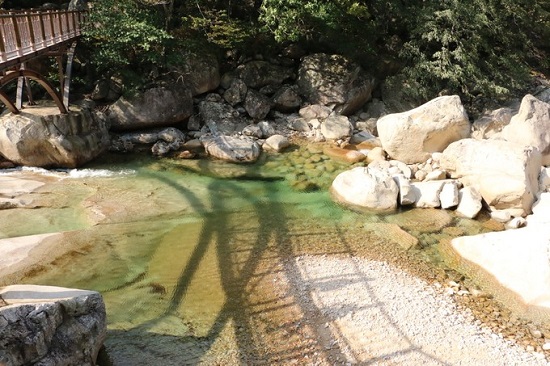
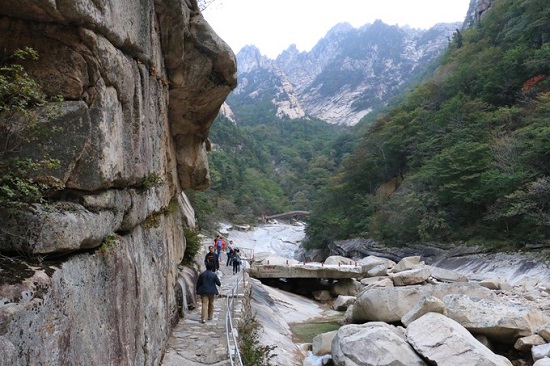
Some of the vistas Kumkang Mountain has to offer.
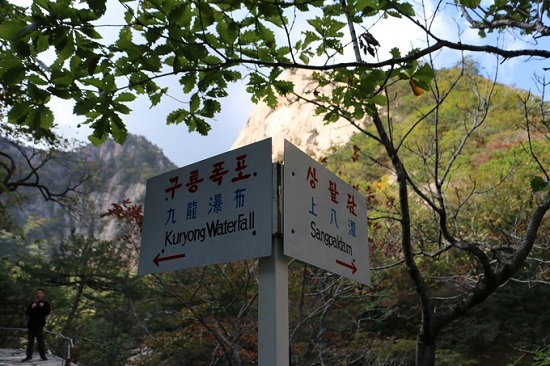
We saw a pavilion. This was almost at Kuryong
Falls. Inside the pavilion was a store selling snacks and beverages.

We hiked nonstop for two hours so that we
could see Kuryong Falls.

This is the scenery at Sang Paldam. I
didn’t go there because it was hard, which I kind of regret. I wasn’t able to
find any good pictures of it online, so instead I’m using a picture that was
painted by a North Korean artist. When I compare it to the pictures taken by my
traveling companions, it is nearly identical. Sang Paldam is as beautiful as a
painting. It is called “Sang Paldam” (eight lakes above) because it contains 8
small lakes.
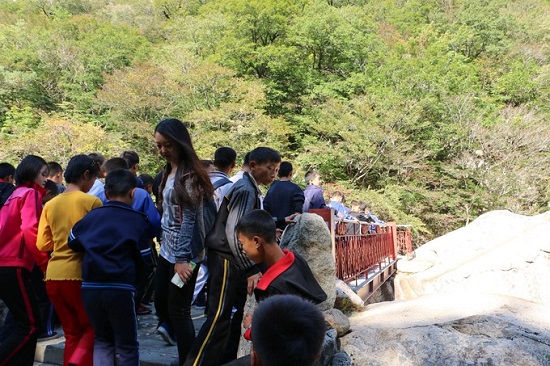
On our way down we passed several groups of
North Koreans, but as they were all walking together they acted like one group.
I felt like the adults had a lifeless look in their eyes, but the children were
bright-eyed and laughing with each other. They were also singing
very loudly, and although I couldn’t understand the lyrics of the song it was
clear that they were singing ardently.

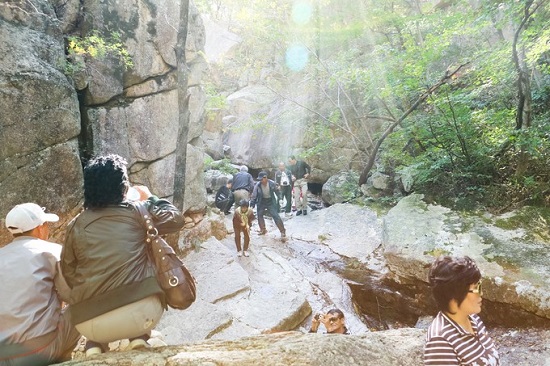
This is where we chose to take our break.
North Koreans are drinking from water bottles. I’ve heard that North Koreans
can’t just go to Kumkang Mountain whenever they feel like it, so after seeing
people wandering around the mountain quite freely I asked our guide about it.
The guide said that he also wasn’t sure what exactly was going on.
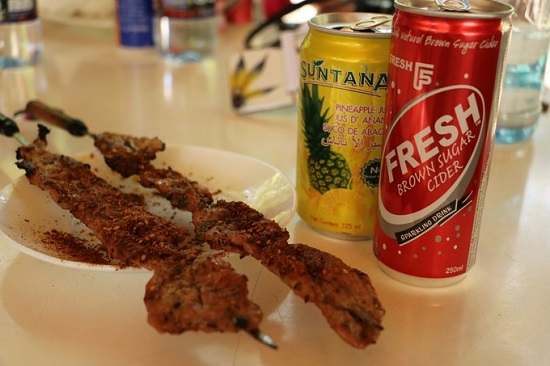
When we arrived back at the parking lot,
there were small vendors selling snacks. They had dumplings, squid, sea
urchins, lamb skewers, and other things like that. I bought two lamb skewers,
which were tastier than I had expected.
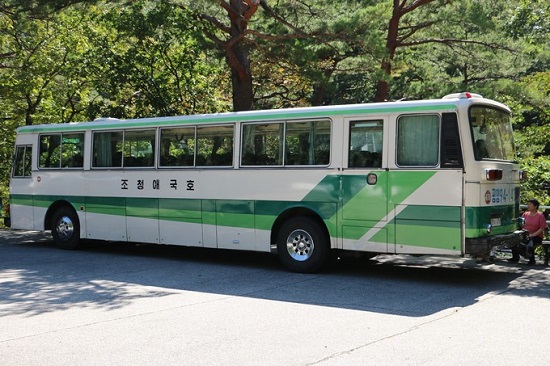
This bus takes North Koreans up to Kumkang
Mountain. I’ve heard that most buses in North Korea are from other countries
which used and then discarded them. (Editor’s note: These buses, known as ‘Jocheong Aeguk Ho,’ are gifts from Chongryon, the General Association of North Korean residents in Japan.)

This was our lunch on day three. Finally we
were able to eat a hot meal. There was Korean-style gochujang (red pepper
paste) on the table, which turned out to be essential. Throughout the trip even
when mediocre food appeared, adding gochujang made it far more palatable. Gochujang was my
daily salvation.

After lunch, we rested on a terrace
overlooking this landscape. I snuck a picture of the two North Korean soldiers
who were in front of us.

During lunch, a stray cat wandered into the
restaurant and wreaked havoc. One of the employees wearing traditional clothing
grabbed the cat and is putting it outside.

A woman scooping up water from the river.
She’s putting water in what looks like an oilcan. Maybe she doesn’t have
running water at home.

Next to us was a green median with a
downward sloping road. If you follow this road all the way down, it leads to
South Korea.
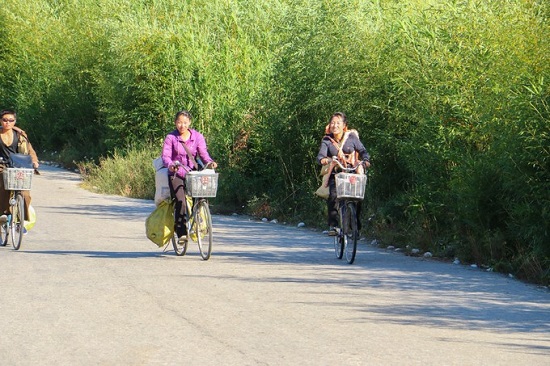
A group of North Koreans passed by on bicycles. Although
the bikes are certainly versatile- they tie things to the bike, carry children
on their backs, and give people rides in the baskets- it looked dangerous.
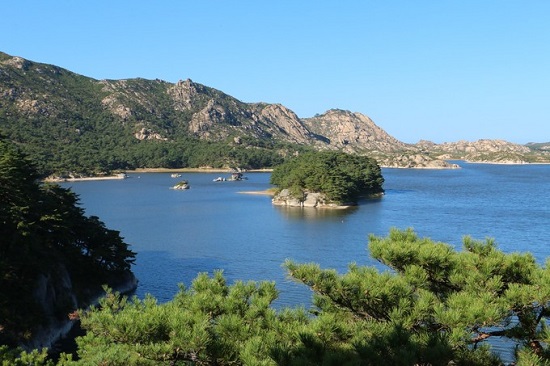
Lake Samilpo (Three Day Lake). Someone told me that there is a story of a Korean King who fell so deeply in love with the scenery here he couldn’t leave for three days. The lake was as beautiful as the story that it is named for.
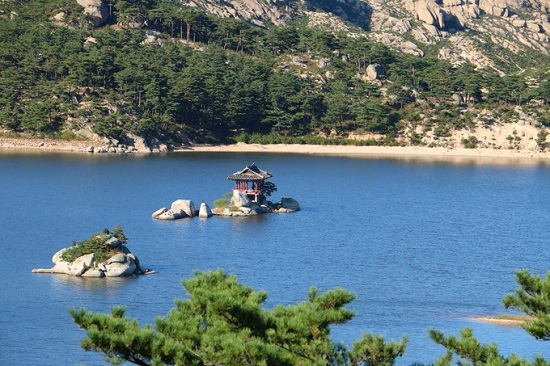
This place is extremely close to South
Korea. As we got closer to South Korea, one of the members in our travel group
started to make fun of North Korea. He started to criticize Kim Jong Un, saying
“Kim Jong Un wanted to launch a missile, but Park Geun Hye warned him not to so
he couldn’t–all he could do was stand around~” This guy even went so far as to
ask our guide what he thought of it.
Our guide was liberal. She talked to us
about South Korean dramas, and unlike other more rigid North Koreans she did
not call Seoul ‘Hansung’, nor did she call South Korea ‘South Chosun’. When she
talked about South Korea, she wasn’t always negative. But this particular
instance was different. As soon as the tourist criticized Kim Jong Un, her face
immediately hardened.
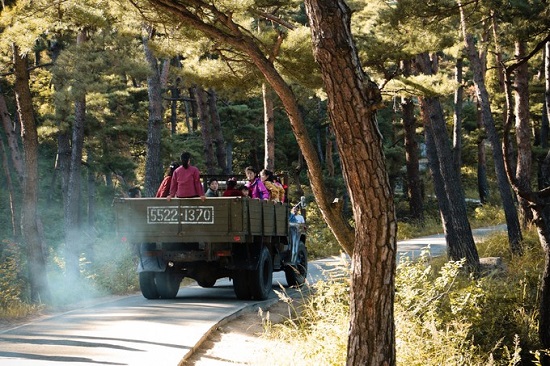
We could often see North Koreans riding in
the beds of trucks in the countryside. Trucks were used and seen frequently. People said a lot of these were powered by charcoal.




















